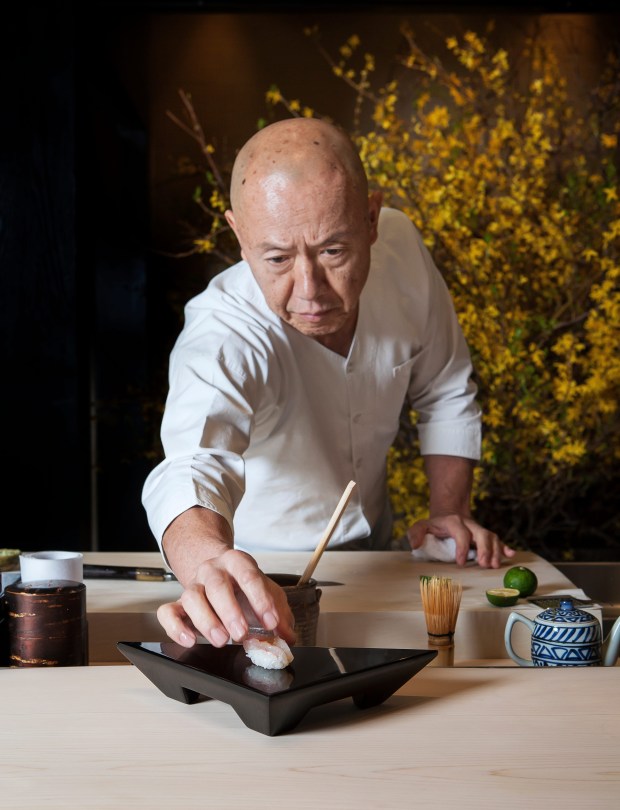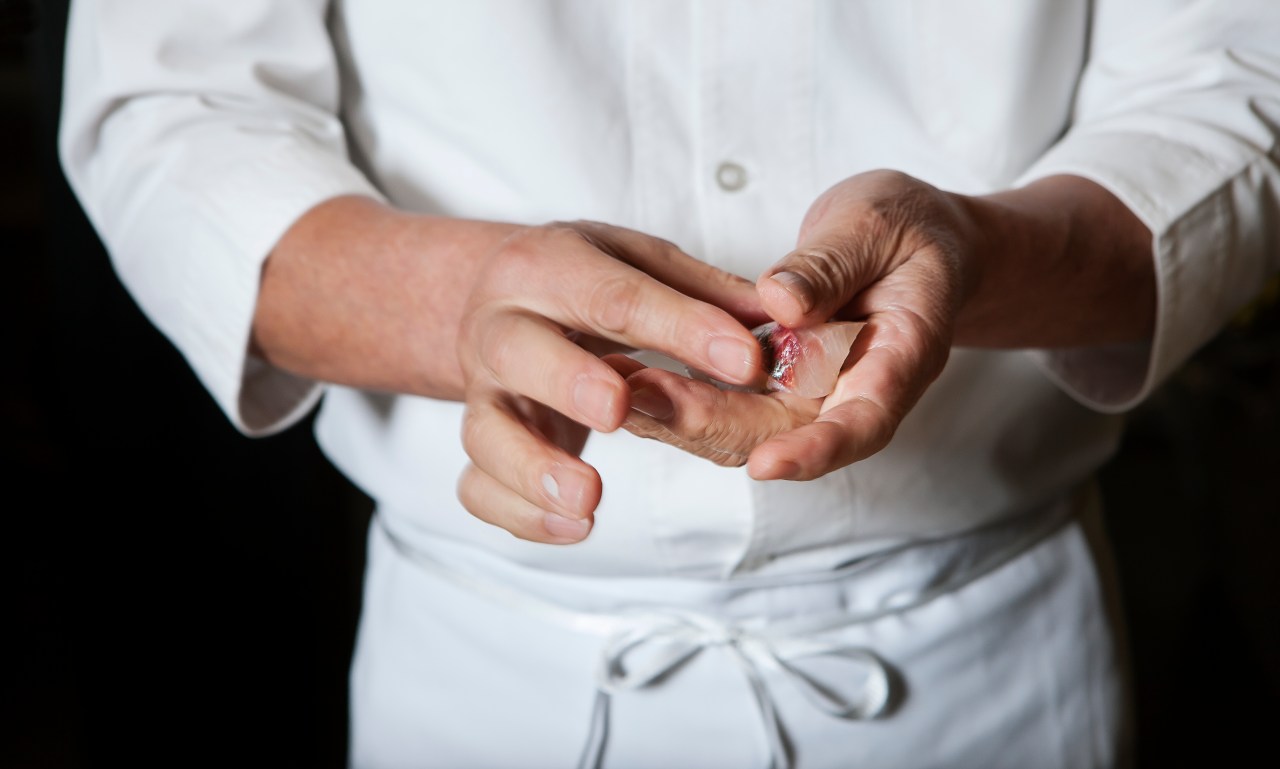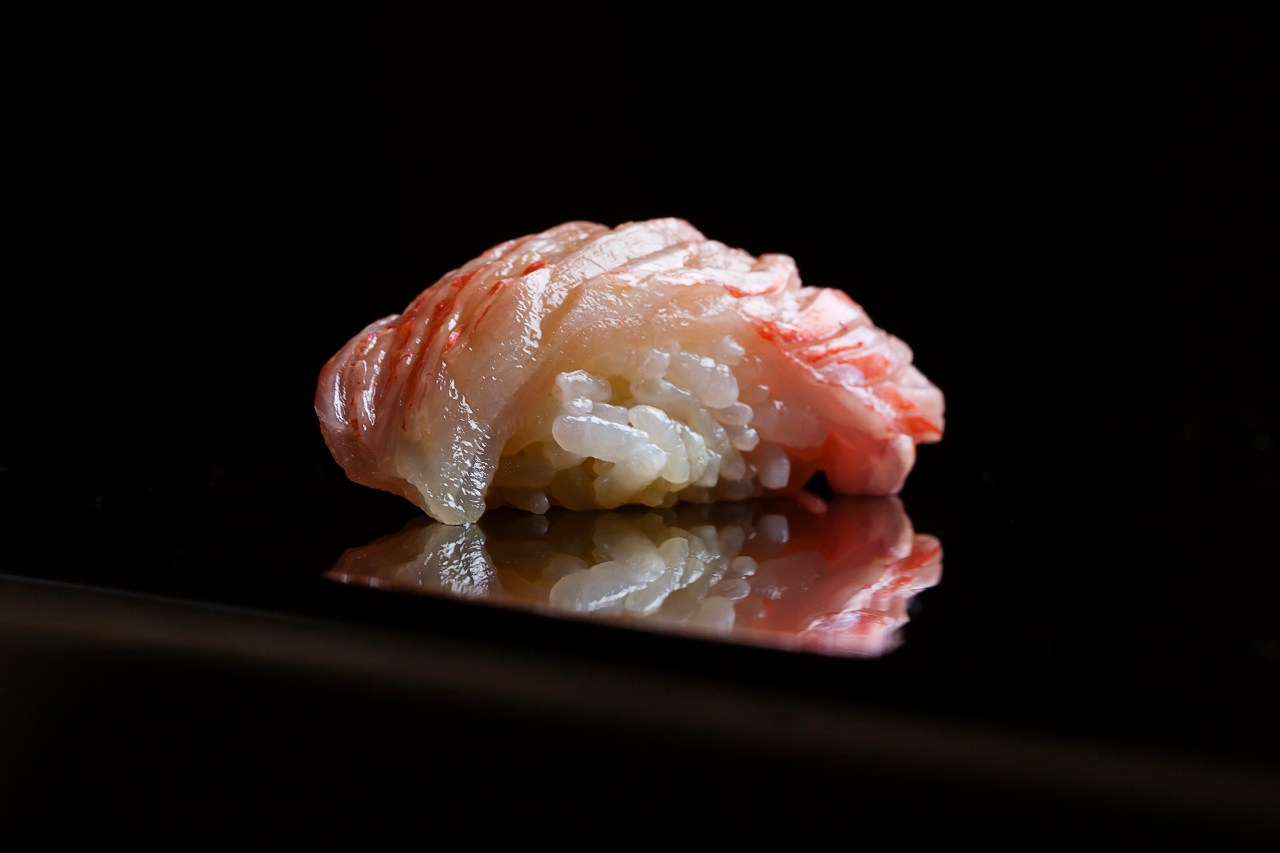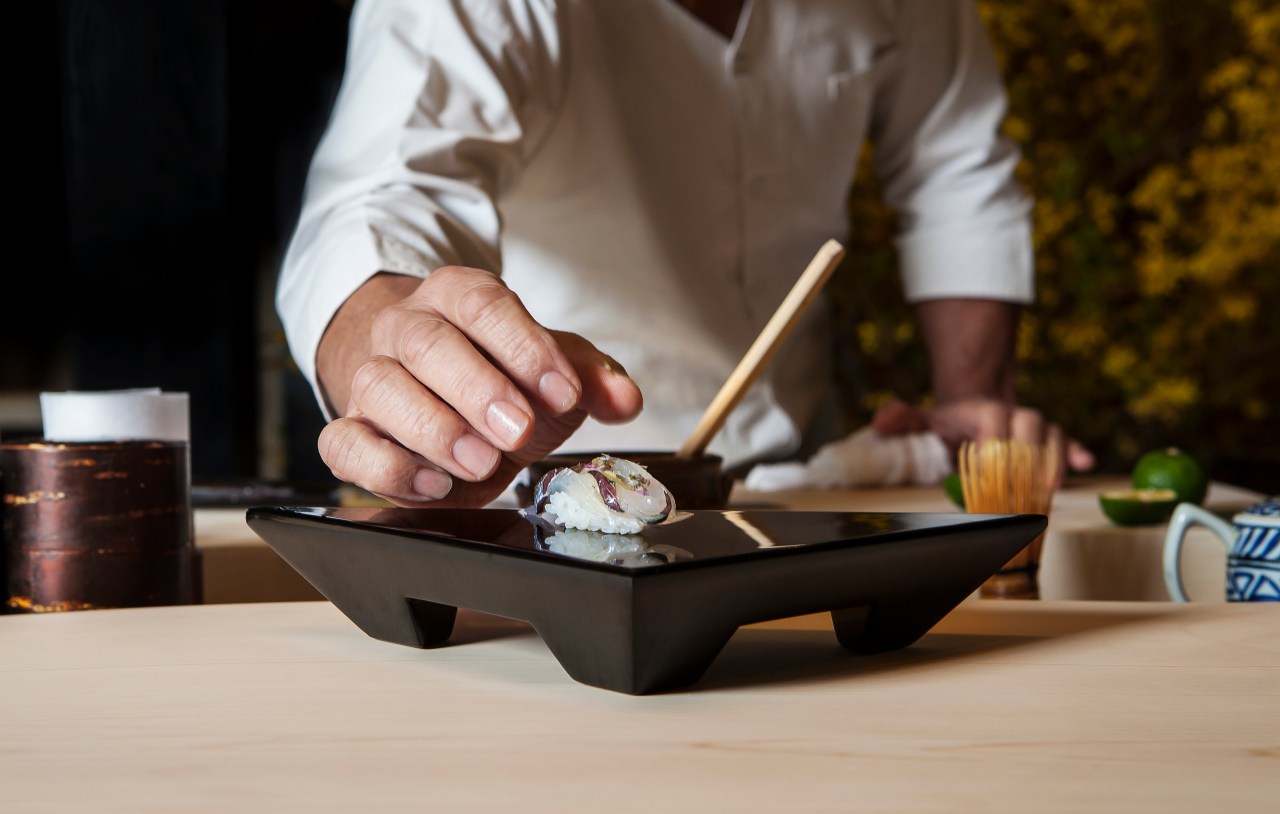It’s a quiet Saturday afternoon in the Time Warner Center in New York City. Well, the Time Warner Center isn’t quiet, but if you’re lucky enough to be inside of famed sushi restaurant Masa—and in the presence of the master Masa Takayama himself—you’ll find yourself in a hush, punctuated by the occasional flash and stroke of Masa’s knives. I’m here to learn about sushi—and I’m pretty sure there’s nowhere better to learn. If you’ve seen the “Parts Unknown” episode that features Masa, you got to see him relaxing with family, with Anthony Bourdain, shopping, cooking at home. The Masa I meet today is in chef regalia, a gentle yet commanding presence behind his famous sushi bar.
First, I watch. Masa begins by grating wasabi—the real stuff, the prohibitively expensive and difficult to grow stuff—not the powder found in many restaurants. After grating, the wasabi gets a caress with a knife, and the care with which it is treated makes one unspoken lesson clear—ingredients, the best of all ingredients, are a prerequisite for impeccable sushi. We chat as he works, turning out beautiful pieces of sushi, works of art in miniature.

Chef Masa is obviously committed to quality—he has his own import company to source the fish for his restaurants. For the last seven years, he’s been importing the fish destined to become one of his creative dishes. Most of the fish comes from Japan, but Masa also imports from Norway and California. During his tenure in California, Chef Masa used to fly to Japan on the weekends to select and bring back the week’s product for his restaurant. This became impractical in New York, so the company was born to ensure Masa receives the highest quality seafood possible. This afternoon, I will taste toro, shima aji, ika, sweet shrimp, saba, sayori, shiitake, and a hauntingly aromatic concoction of black truffle, parmesan, truffle paste, and salt. The fish are from a dizzying array of locations, the sushi rice, cooked at what I learn is the perfect temperature, doused lightly with accents like soy—Masa prefers light soy because “the fish is the main character”—and shavings of sudachi, a Japanese citrus that is not eaten as a fruit, but used as food flavoring in place of lemon or lime.
This commitment to quality is likely borne of a lifetime spent in and around food. Masa’s family used to own a fish company, and he learned the business on the ground. “Even before junior high, I’m helping in the family business. Sometimes, in high school—we did weddings, a hundred people, two hundred people—sometimes I’d take three or four days off of school, to help and prep,” he remembers. From there it was on to an eight-year-long apprenticeship at Ginza Sushi-Ko in Tokyo (still the place he recommends for a truly great sushi meal when you are in town).
We talk about training—eight years is no small chunk of time, especially when you don’t even get to touch rice for the first three. Masa says, “The thing is, at the very beginning, people don’t know anything, right? So, of course, they don’t touch rice, they don’t touch fish because they don’t know how to cut the rice or the fish. They must learn little by little.” I ask if this is achieved through watching. Yes, he says, “little by little. They get to know what the reason is, why we make the sushi rice this way, watch and steal ideas, techniques. I cannot teach one to a hundred—we teach one to ten. After that, it’s important for the person to catch up and know what the point is.” He continues, saying that people learn basics, but after that, they must have their own style and that each piece must be perfect. I ask about muscle memory, the way a great ballerina must study for years to perfect her pirouettes. Masa’s answer is predictably charming: “I think sushi or any other cuisine—it is like a ballerina, you know—that sense of feeling, presenting the sushi or dishes, that’s a very important thing. Placing the plate the right way; there are so many ways to slice, and that can change the whole experience.”

After training at Ginza Sushi-Ko, it was on to Los Angeles where he recalls, his patrons were more Japanese than at his later restaurant in Beverly Hills. There, he says, “The customers were eighty percent local and mostly American, so I changed some dishes—not Americanized, but some dishes are very difficult to eat for American people, so I just created ways to make them easier.”
Intrigued by this, I ask Masa about the changing attitudes toward sushi, as he has seen it from his years behind the counter. He says the palate has changed immensely over the years. “Before, sea urchin was not popular, but now the last five years they love it. Before, customers would say all of the time, ‘I don’t eat squid, I don’t eat octopus, I don’t eat sea urchin.’ It was always, they’re thinking, the squid is chewy, but it is very soft and sweet. Very much today people will eat everything unless they have an allergy.”
Despite hosting a constantly full house and overseeing a growing empire, Masa says he still makes sushi at home for his family. The passion for food runs in the family: Catherine Takayama, Masa’s daughter, is the pastry chef at the French Laundry. I ask him if they talk shop. “We talk a lot, she sends me pictures and asks me to look. I can’t taste it, but I advise her. What I do is very simple, plain, right? Sometimes I tell her, too much stuff, too fancy!” If you’ve ever been lucky enough to dine at Masa, you’ll know that clean and natural are the reigning aesthetics at play.
This is what I’m here to find out—the crux of the lesson. I ask Masa, “What makes great sushi?” Without hesitating, he replies, “The most important thing is the rice. Well, not most important, but important. This is the temperature of the rice, the fluff, the vinegar, the vinegar with the salt, a little sweetness, a balance.” Foolishly, I ask why. Masa replies, “Some fish are cured, some are raw, some are fatty, some have no fat, this rice is supposed to go with all different ingredients nicely, perfectly.”
The lesson continues, “Soft water makes fluffier rice than hard water, and then after that, the thing is the right time for dunking it in the big, wood barrel and quickly cutting the sushi rice with vinegar, that’s a very difficult task–every single grain must catch the same amount of vinegar. Sometimes, too, I change the vinegar ratio, this is very delicate, maybe the most important thing.”
Softness is important, I ask? “You know, sometimes, you get a kind of sushi that is very hard; the rice and fish have been squeezed too hard. Too soft is not good, either. So nicely, gently, hold the sushi the way you would hold a bird in your hand. Very gently. The human mouth is very delicate. When you put it in the mouth, the rice should be slightly warm, the fish chilled cold enough, you want it to be a gentle mix of all of the senses.”
It’s been a quiet, lovely afternoon, and preparation is underway for the dinner service. Quietly, and orderly, employees are showing up. It’s time for me to go back to the real world, where nothing is as perfect as Masa’s sushi.

At Masa, the staff does a presentation on how to maximize enjoyment of the meal before service begins. (For instance, the sushi pieces are eaten by hand, not with chopsticks.) Masa speaks passionately about people “ruining” their sushi with wasabi and soy sauce. Beyond that, says Masa, “For people to enjoy the food, it’s better if they don’t talk loudly, don’t use cell phones—no cell phones. No pictures. Sometimes, people come for a celebration and we allow a photo, but not for each dish, no.” Much has been written about the delicate hinoki wood of the bar at Masa—it’s true, it glows. For Masa, the aesthetic value is as important as the taste, which explains the intricate sourcing and designing he does for the vessels that convey the ever-rotating, seasonally-focused dishes and sake pairings to lucky guests. Think rare lacquers made from tree sap, crafted by traditional Japanese methods—natural materials designed to harmonize with the cuisine.
Masa designs the ceramics but works with different artists from all over Japan. He travels around the country finding people who specialize in different things like cast iron, porcelain, certain types of ceramics—right now he’s working with someone in Kyoto who makes a very traditional, very elegant type of ceramic porcelain called kiyomizu. It’s a lot of work but the staff says he really enjoys it.
I ask Masa a clumsy question—what does he enjoy most about his job?— and receive a disproportionately elegant and gracious answer: “The great moment in this kind of job or any other job, is when the audience, the customer, they enjoy and they love it. That moment is very enjoyable, that’s why we do this every single day. Prep perfectly, serve perfectly, present perfectly—that is what we are trying to do.”

